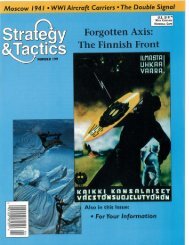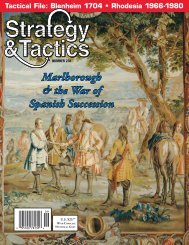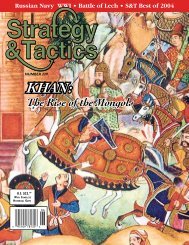COUNTERSTROKE AT SOLTSY - Strategy & Tactics Press
COUNTERSTROKE AT SOLTSY - Strategy & Tactics Press
COUNTERSTROKE AT SOLTSY - Strategy & Tactics Press
You also want an ePaper? Increase the reach of your titles
YUMPU automatically turns print PDFs into web optimized ePapers that Google loves.
The Turks<br />
The Ottoman Turks were once the mightiest military power in Europe, but by the 18 th century<br />
they had begun their long slide into eventual dissolution as an empire. The last real threat<br />
the Turks posed to Europe was in their 1683 invasion that reached the gates of Vienna before<br />
being driven back.<br />
One reason for the Ottoman decline was the devolution of power from the central government<br />
in Constantinople toward local feudal lords, the latter having their own interests that<br />
were not necessarily those of the sultans. The Ottomans could no longer mobilize the kinds of<br />
armies they once did for massive invasions. All that was happening at a time when the European<br />
powers were becoming more centralized and their armies more professionalized.<br />
The Ottoman military had traditionally been a combination of professionals, feudal levies<br />
and auxiliaries. The professionals included the Janissaries, who were elite infantry, and<br />
Sipahis (or Spahis), who provided regular cavalry. Ottoman nobles were required to provide<br />
levies of troops, and some of those were good. Finally, there were numerous auxiliaries, such<br />
as the infamous Bashi-bazouks, who came along for the loot. In the 18 th century, warlords<br />
raised many of the empire’s armies, and while theycould often be effective in the field, they<br />
did much to undermine the power of the government in Constantinople, since the local armies<br />
were often used to maintain the nobles’ power.<br />
On the battlefield, Ottoman tactics relied on mobility, perhaps too much so. Skirmishers<br />
would snipe at the enemy while cavalry would maneuver to envelop a flank. The Ottomans<br />
brought along large numbers of artillery to provide a base of fire. What the Ottoman system<br />
lacked was well disciplined infantry capable of firing in ranks. Instead, skirmishing was the<br />
order of the day. Even the Janissaries tended to fight in loose formations emphasizing individual<br />
action. By tradition, each Janissary could choose his own weapon from the Ottoman<br />
arsenals before going on campaign. Indeed, there is a certain irony there, for while European<br />
armies of the 18 th century are sometimes criticized for being too rigid and neglecting their own<br />
light troops, in the Ottoman military the situation was the opposite.<br />
There were men in the Ottoman Empire who tried to organize European-style army units, with well disciplined volley fire<br />
by the troops. But the innovators were resisted by traditionalists who saw nothing wrong with the system, or, believed if there<br />
was something wrong it was that traditional methods were no longer being fully applied. Too much change would undermine the<br />
traditional power bases of the empire, especially those like the Janissaries who had a vested interest in keeping affairs, especially<br />
military affairs, the way they were. In the end, the Ottomans would pay for that lack of foresight with defeat in a long and dreary<br />
series of wars with Austria and Russia.<br />
Catherine expanded Russia’s borders to absorb eastern<br />
Poland, the Crimea and Black Sea littoral, and the<br />
western Ukraine.<br />
Catherine also decided to reverse the Turkish conquests<br />
of the last several centuries by invading the Ottoman<br />
Empire. To that end, she supported Greek rebels<br />
and even sent a fleet to the eastern Mediterranean. That<br />
was an impressive feat for the day, given the general<br />
Russian inexperience in naval matters. The Russian<br />
fleet defeated the Turks in June 1788 in the Aegean.<br />
That victory, in conjunction with Russian and Austrian<br />
land advances in the Balkans, could have brought<br />
the Ottomans to their knees, but the Turks were saved<br />
when the other European powers intervened in order<br />
to maintain the balance of power. Still, Russian naval<br />
operations were an impressive display of military<br />
power.<br />
One of Catherine’s great triumphs was the partition<br />
of Poland. It was actually a series of land grabs by<br />
Russia, Austria and Prussia, working together in 1772,<br />
1793 and 1795. The result was the Polish state, once<br />
one of the most powerful in Europe, disappeared from<br />
the map and did not re-emerge until the chaos following<br />
World War I in 1918. While that seemed to be a<br />
violation of the balance of power, it was a special case<br />
in which the three great powers of eastern Europe were<br />
united in their objectives. More, Poland was located in<br />
the center of the three and on the front of their geopolitical<br />
lines of expansion. Another reason the great powers<br />
could partition the country was the Poles were fighting<br />
among themselves and were unable to offer a united resistance.<br />
Domestically, Catherine was in the same predicament<br />
as other Enlightenment monarchs. While advocating reform,<br />
too much reform would undermine her own power<br />
and that of the aristocracy who supported her. Inevitably,<br />
her reforms strengthened the power of the state by increasing<br />
revenues and reinforcing the military.<br />
The extent of Catherine’s accomplishments can be<br />
seen by looking at the map. The territory she gained for<br />
Russia exceeded in extent that of the entire Prussian kingdom.<br />
The effectiveness of the system she left to her descendants<br />
on the throne could be seen in the following<br />
decades, when Russia provided the wherewithal to defeat<br />
the forces of the French Revolution and Napoleon.<br />
strategy & tactics 27







